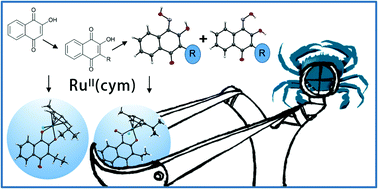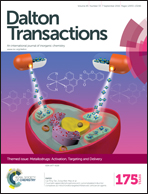Towards targeting anticancer drugs: ruthenium(ii)–arene complexes with biologically active naphthoquinone-derived ligand systems†
Abstract
Anticancer active metal complexes with biologically active ligands have the potential to interact with more than one biological target, which could help to overcome acquired and/or intrinsic resistance of tumors to small molecule drugs. In this paper we present the preparation of 2-hydroxy-[1,4]-naphthoquinone-derived ligands and their coordination to a RuII(η6-p-cymene)Cl moiety. The synthesis of oxime derivatives resulted in the surprising formation of nitroso-naphthalene complexes, as confirmed by X-ray diffraction analysis. The compounds were shown to be stable in aqueous solution but reacted with glutathione and ascorbic acid rather than undergoing reduction. One-electron reduction with pulse radiolysis revealed different behavior for the naphthoquinone and nitroso-naphthalene complexes, which was also observed in in vitro anticancer assays.

- This article is part of the themed collection: Metallodrugs: Activation, Targeting, and Delivery

 Please wait while we load your content...
Please wait while we load your content...